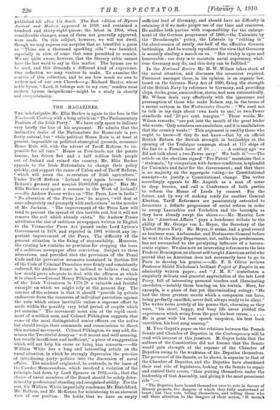HYMNS ANCIENT AND MODERN.* Tun volume is the complement of
the new edition of Hymns Ancient and Modern which appeared in 1904. It is a book for the study, being an octavo of the largest size ; indeed, the mass of information which it contains, over and above the hymns themselves, with the originals in the case of translations, requires no small space,—the volume contains more than nine hundred pages. (Would it not be possible to give in parish magazines the hymns for the whole month ? Many worshippers would find pleasure and profit in learning what is to be known about the words which they are going to sing.) First comes the introduction, written by the Rev. W. H. Frere, with a highly interesting account of hymnody in the Church from the earliest time down to the present day. The earliest hymn is of Greek origin, "Hail, gladdening light," the Os lAapor which is still used as an evening hymn in the Eastern Church. Its authorship and date are un- known; but it was in common use by the middle of the fourth century. This brings before us the great name of St. Ambrose of Milan. "0 Splendour of God's glory bright" and "0 come, Redeemer of the Earth" are his, almost beyond doubt. Sixteen more—of which five are to be found in Hymns Ancient and Modern—are with more or less probability attributed to him. All have this at least to be said for them, that they are used in the Milan Liturgy. To pass per saltum to Anglican hymnody, we find the earliest name in Thomas Sternhold (d. 1549). His work, which was confined entirely to the Psalter, was carried on by his pupil John Hopkins. The whole appeared in 1562. Meanwhile some hymns proper came into existence, though it was long before they were taken into general use. Among the earliest are Bishop Ken's three for morning, evening, and midnight. These were first published in 1695 in an appendix to a manual of prayers which he had drawn up for Winchester scholars some twenty years earlier. The first of modern hymnals is that of Bishop Heber. He used it in his parish of Hodnet, but it was not • Historical Bditics of Him= .Aociest and Modern. London: W. Clowns and Sons. [12s. 6d. net.]
published till after his death. The first edition of Hymns Ancient and Modern appeared in 1859, and contained a hundred and thirty-eight pieces ; the latest in 1904, when considerable changes, some of them not generally approved, were made. On this subject, however, we will not dwell, though we may express our surprise that so beautiful a poem as "Thine are a thousand sparkling rills" was banished, especially in view of some that were permitted to remain. We are quite aware, however, that the literary critic cannot have the last word to say in this matter. The hymns are to be used, and this demands a different kind of experience. One reflection we may venture to make. To examine the sources of this collection, and to see how much we owe to writers not of our own Church—e.g., Richard Baxter, whose noble hymn, "Lord, it belongs not to my care," renders most modern hymns insignificant—might be a study in charity and comprehension.











































 Previous page
Previous page